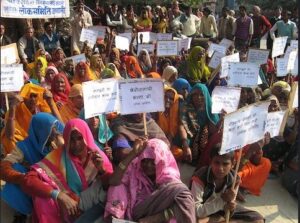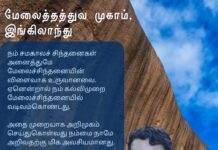
In the many emails that I receive daily, a young reader once asked ‘What is the use of India’s freedom? It is the British that laid railroads, built ports, set up police stations and courts, established law and order, connected the entire nation with communication networks and setup a robust administrative structure. Had they continued, this country might have developed still further, isn’t it? What did we get after freedom? Corruption and exploitation everywhere. The British were far better than these corrupt people, isn’t it?’
Every three months, at least one young person ends up asking me something similar. This is because, this is a common question that pervades our tea shops. Whenever the topic of politics arises, atleast one elderly person would comment ‘The rule of the foreigner went and the rule of the looters came to replace it’ [the original Tamil text uses the words vellaikaaran (the white man) and kollaikaaran (looter), the alliterative effect unfortunately could not be preserved in the English translation]. But when we say this, we hardly consider history. Those who comment with a sense of history are extremely rare among us.
What is the truth? It is true that British rule was behind the aforesaid developments. It is not the munificence of the British. It is the munificence of modern capitalism. It happened throughout the world around the same time.
But along with it, British rule caused unprecedented great famines in this country. Even English historians have written extensively about this. Amartya Sen has done research on these famines. For twenty years from 1769, and another twenty years from 1837, great famines came over India. Our forefathers have referred to them as ‘Thadhuvaruda panjam’. There were other famines as well in between these two famines. The British have cleverly separated them into smaller famines naming them as the Bengal famine, the Deccan famine and recorded them in history.
The truth was that for a hundred and fifty years India was continuously in famine. Before the advent of the British, there were smaller famines. Never a great famine. It was the British rule that caused these great famines. They have been proved by researchers as having been caused artificially.
The Indian mainland receives rainfall from monsoons. Whenever the monsoons fail, food shortage has been a common occurrence throughout generations. Hence, there was a well known solution to handle these famines in India. The solution was to migrate to places where food was available.
As India was a large country, whenever the east had a famine, the west would have a bumper harvest. In both the ‘Thadhuvaruda panjams’ (famines), the western parts of India had a good harvest. But Roy Moxham, a British researcher, records how this method of handling famine was brought to naught by British rule in his book ‘The Great Hedge of India’. This book was traslated into Tamil and was came out with my preface. In the 1750’s, the British constructed a fence from Orissa to Kashmir that split India vertically. It is one of the longest hedge of thorn bushes constructed across the world. They constructed thousands of gates across this hedge, controlled the movement of cargo and collected toll tax. Hence, a situation arose that the grains from western India couldn’t reach and help the famine conditions in eastern India.
Further, the British connected ports such as Vishakapatnam, Mumbai, Nagapattinam and Karaikal through railroads and exported grains grown here to other parts of the world under their dominion. In those days, the British were engaged in hundreds of battlefronts across the world where they were fighting for world domination. All the food requirements for that was met from here. While people were succumbing to famine, food was being exported. Today, researchers are documenting all of these. As a result of these famines, a third of the Indian population succumbed.
In the first of these famines, three crore people might have died; seven crores in the second. An equal number set sail as refugees and settled all over the world, in Mauritius, New Zealand, Malaysia, Sri Lanka, South Africa and the Caribbean Isles. In the places where they sought refuge, they died in scores due to communicable diseases.
No country in the world has been visited by such famines. Never have so many people died like this as well. I have provided an extensive outline of this in my novel ‘Vellai Yanai’ (The White Elephant). It is not a simple issue that millions of people died in famine in this modern age. A man doesn’t die because of lack of food for one or two days. The soul will leave the body only when not even a single mouthful of food is available for a period of fifteen to twenty days.
By even British accounts, in Coimbatore alone, a single day saw twenty thousand corpses. Thirty thousand corpses were buried in Chennai in a single day. Mostly women, children and the elderly. Local bards have recorded the hunger deaths of those days under the name ‘Thadhuvaruda kummi’ (Lyrics of the Famine)
Even during the Indian freedom struggle, a great famine existed throughout India. Madhushree Mukherjee, a reseacher, has documented how the British Prime Minister, Churchill, attempted to derail the Indian war for independence through hunger. Even in 1942, an estimated thirty thousand people perished in famine.
In 1947, India attained independence. The same administrative setup. A financial state that was worse than during British times. There was barely a treasury for the government. The remaining assets had already been partitioned with a half apportioned to Pakistan. Nehru took charge as India’s prime minister. But not a single person was let to perish. Nehru went around the world begging for alms and the grains received were converted into feeding troughs with porridge for the hungry to ensure that nobody died. Jaiprakash Narayan, who is hailed as the ‘Hero of the Feeding Troughs’ ensured that not a single person died of famine in Bihar.
Nehru was able to convert India into a self-sufficient state in terms of food requirements within barely 25 years by constructing dams, increasing the area under agriculture and raising food production through the first five year plan. Even today, hunger exists in India. But we never hear of somebody dying of hunger. What we had before 1947 was an alien power. They were scarcely bothered when we perished in millions. They conducted grand festivities. They celebrated with huge feasts. After 1947, what came was our elected government – hence, when we suffered in famine, Nehru couldn’t sleep in his palatial PM’s residence.
This is the benefit we received out of our independence: I noticed a note in the library of the University of Brickley. Nehru had written a letter to the state of California in supplication when India was suffering from famine. They had collected money and sent it to us. In the note of thanks that Nehru sent them, he had written ‘We cannot repay you this money. We are sending a few books in affection. Please accept them.’
When I was reading that letter, an NRI next to me said ‘See sir – they are insulting us by framing our letters where we sought alms from them’. I said, ‘Nehru didn’t seek alms for himself. Not for his kin. For his countrymen. Should we not be proud that we had a leader who surrendered his self respect and begged for the reason that none of his countrymen should die of hunger?’ I couldn’t read that letter without tears in my eyes.
If you ask what we achieved through independence, it is this. A government that worries about us and a leader who leads it. If we lost such politicians, it is our fault. We are faulting our ancestors for our own incompetence and our lack of integrity. This is stooping to a new low. (2016)
Translated by Gogul











